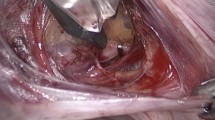Abstract
Background
To evaluate the efficacy and safety of temporary simultaneous two-arterial occlusions (TESTO) in terms of operative blood loss during laparoscopic myomectomy.
Methods
A total of 62 patients with symptomatic myomas were randomly assigned to either the experimental group or the control group. In the experimental group, the uterine arteries and utero-ovarian arteries were temporarily occluded with laparoscopic bulldog clamps. The primary outcome measures were operative blood loss and change in hemoglobin.
Results
There were no differences in baseline demographics between the two groups. The amounts of operative blood loss (56.3 ± 42.8 mL vs. 138.2 ± 48.8 mL, p < 0.001) and change in hemoglobin (1.0 ± 0.5 g/dL vs. 1.7 ± 1.1 g/dL, p = 0.002) were significantly lower in the experimental group than that in the control group. The total operative time was not significantly different between the two groups. However, it took less time for myoma enucleation (13.1 ± 14.6 min vs. 17.6 ± 10.4 min, p = 0.006) and for uterine suturing (19.5 ± 10.7 min vs. 24.6 ± 8.8 min, p = 0.006) in the experimental group than that in the control group. None of patients in both groups developed operative complications.
Conclusion
The use of the TESTO procedure is effective in reducing operative blood loss and hemoglobin loss without causing morbidity during laparoscopic myomectomy.

Similar content being viewed by others
References
Kongnyuy EJ, Wiysonge CS (2011) Interventions to reduce haemorrhage during myomectomy for fibroids. Cochrane Database Syst Rev 11::CD005355
Downes E, Sikirica V, Gilabert-Estelles J, Bolge SC, Dodd SL, Maroulis C, Subramanian D (2010) The burden of uterine fibroids in five European countries. Eur J Obstet Gynecol Reprod Biol 152:96–102
Sami Walid M, Heaton RL (2011) The role of laparoscopic myomectomy in the management of uterine fibroids. Curr Opin Obstet Gynecol 23:273–277
Donat LC, Menderes G, Tower AM, Azodi M (2015) A technique for vascular control during robotic-assisted laparoscopic myomectomy. J Minim Invasive Gynecol 22::543
Baydo S (2016) Laparoscopic multiple myomectomy with controllable ischemia. https://www.youtube.com/watch?v=_zOc7baIKhk
Song T, Kim TJ, Lee SH, Kim TH, Kim WY (2015) Laparoendoscopic single-site myomectomy compared with conventional laparoscopic myomectomy: a multicenter, randomized, controlled trial. Fertil Steril 104:1325–1331
Song T, Kim TJ, Kim WY, Lee SH (2015) Comparison of barbed suture versus traditional suture in laparoendoscopic single-site myomectomy. Eur J Obstet Gynecol Reprod Biol 185:99–102
Dindo D, Demartines N, Clavien PA (2004) Classification of surgical complications: a new proposal with evaluation in a cohort of 6336 patients and results of a survey. Ann Surg 240:205–213
Vassiliou MC, Feldman LS, Andrew CG, Bergman S, Leffondre K, Stanbridge D, Fried GM (2005) A global assessment tool for evaluation of intraoperative laparoscopic skills. Am J Surg 190:107–113
Dubuisson J, Ramyead L, Streuli I (2015) The role of preventive uterine artery occlusion during laparoscopic myomectomy: a review of the literature. Arch Gynecol Obstet 291:737–743
Taylor A, Sharma M, Tsirkas P, Di Spiezio Sardo A, Setchell M, Magos A (2005) Reducing blood loss at open myomectomy using triple tourniquets: a randomised controlled trial. BJOG 112:340–345
Al-Shabibi N, Chapman L, Madari S, Papadimitriou A, Papalampros P, Magos A (2009) Prospective randomised trial comparing gonadotrophin-releasing hormone analogues with triple tourniquets at open myomectomy. BJOG 116:681–687
Vercellino G, Erdemoglu E, Joe A, Hopfenmueller W, Holthaus B, Kohler C, Schneider A, Hasenbein K, Chiantera V (2012) Laparoscopic temporary clipping of uterine artery during laparoscopic myomectomy. Arch Gynecol Obstet 286:1181–1186
Peixoto AB, Da Cunha Caldas TM, Tonni G, De Almeida Morelli P, Santos LD, Martins WP, Araujo Junior E (2016) Reference range for uterine artery Doppler pulsatility index using transvaginal ultrasound at 20-24w6d of gestation in a low-risk Brazilian population. J Turk Ger Gynecol Assoc 17:16–20
Dubuisson J-B, Malartic C, Jacob S, Chapron C, Rambaud D (2004) Preventive uterine artery occlusion combined with laparoscopic myomectomy: a valid procedure to prevent bleeding. J Gynecol Surg 20:105–112
Author information
Authors and Affiliations
Corresponding author
Ethics declarations
Disclosures
Drs. Hwa Cheong Kim and Taejong Song have no conflicts of interest or financial ties to disclose.
Electronic supplementary material
Below is the link to the electronic supplementary material.
Supplementary material 1 (MP4 193117 KB)
Rights and permissions
About this article
Cite this article
Kim, H.C., Song, T. Temporary simultaneous two-arterial occlusion for reducing operative blood loss during laparoscopic myomectomy: a randomized controlled trial. Surg Endosc 33, 2114–2120 (2019). https://doi.org/10.1007/s00464-018-6482-8
Received:
Accepted:
Published:
Issue Date:
DOI: https://doi.org/10.1007/s00464-018-6482-8




